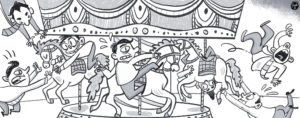Many provinces in the Philippines are now becoming tourist destinations filled with booming infrastructure developments, and business establishments initiated by their local government units (LGUs) with the aid of foreign and local investors. While this has created jobs and economic opportunities for some, what is overlooked is the fact that as we are slowly undergoing this rite of passage from urban to rural, community-based artists and cultural workers are being left out and are not being engaged in the cultural affairs of the community.
This gap in LGU perspectives misses an important aspect in fostering a more complete understanding of the identity of a community. Many community-based artists and cultural workers are not made to become part of the subject of history in institutions and agencies like museums, libraries, historical societies, and cultural centers, or in the creation of local culture and arts councils even though they produce the cultural work. They are rarely seen as playing a significant role in community development, because of the belief that artists are not capable of administering, planning, promoting, and executing specific art programs. But if they are excluded from these institutions that serve as the platforms by which history and policies are concretized, then it’s not a complete story for the community.
Several individuals, art groups, and cultural organizations from the Kurit-Lagting Art Collective, United Architects of the Philippines Student Auxiliary Area B District 5, and the Concerned Artists of the Philippines Bicol Chapter, have expressed their concerns about this kind of treatment of arts and culture and artists and cultural workers. These groups have been initiating their own art programs and cultural events independently for several years now. Through the arts, they have advocated for basic sectors’ rights, environmental issues, and social concerns for the betterment of their communities, and are thus calling on lawmakers and LGUs to ensure that a democratic cultural policy is put in place, to promote greater public accessibility and empowerment among the people.
Such a cultural policy should articulate and demonstrate how public interest is being served and how public funds are being spent. It should also be understood fully by the institutions involved that the cultural policy encompasses a much broader array of activities than what has been traditionally attributed as a thrust in the arts, such as holding art competitions and festivals. This would involve support not only for all art disciplines but also for publicly-supported heritage preservation, artists’ residencies, sustainable art-making practices, creative economies, and a policy of consulting artists, art groups, and cultural organizations whose representatives can speak out and defend the community, particularly the cultural sector. This also includes assistance for educational programs in the arts and humanities offered by barangays, public schools, and universities.
Allowing representatives from the cultural sector to participate in crafting policies that affect them and their fields of work, and consulting them on local ordinances meant to support and implement art programs in the community, are ways to go forward. Public trust is gained when there is inclusive participation by the cultural sector, requiring solidarity, cooperation, and collaboration with lawmakers and local government units. It is just as crucial that those tasked to head the cultural affairs of institutions should recognize that cultural policies need to be collectively designed.
Lastly, the current pandemic underscores how an inclusive cultural policy should expand to also taking care of the arts and cultural sector, through an infrastructure of security, health, social protection and assistance, education, housing, and labor benefits extended to them. This would ensure that artists can do their work of making lives better for their communities.
——————
Choi Despi Carretero is a Bicolano curator, multidisciplinary artist, and community development worker. He is finishing his Master of Fine Arts degree at the University of the Philippines in Diliman, Quezon City.


